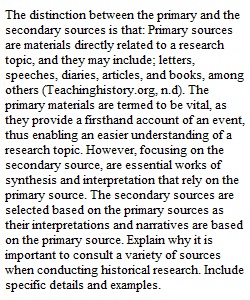


Q Overview Using relevant and trustworthy sources is a key element of conducting research in any field. Primary and secondary sources provide information necessary for historians to develop theories or interpretations about the past. In this activity, you will explore the existing literature relevant to your research question and identify one primary and one secondary source that will help you answer your research question. Please remember to review and keep all instructor feedback. Each module activity will prepare you for an aspect of your final project, and you will have a future opportunity to improve your work. Prompt Use the provided Module Two Activity Template: Primary and Secondary Sources Word Document to complete this activity. You will first discuss the differences between primary and secondary sources and articulate why using both are essential to historical research. You will then identify sources relevant to the research question you wrote in the previous module. Finally, you will identify a current event related to the subject of your historical research question. Specifically, you must address the following rubric criteria: • Distinguish between primary and secondary sources. o What are the differences between them? • Explain why it is important to consult a variety of sources when conducting historical research. o Why should you avoid relying only on one type of source? What are the benefits of using a diversity of sources? • Identify one primary source that would help investigate your research question. o Using the HIS 100 Library Guide in the Shapiro Library, skim through the suggested resources or find your own. Ensure they are credible and relevant to your research question. • Identify one secondary source that would help investigate your research question. o Using the HIS 100 Library Guide in the Shapiro Library, skim through the suggested resources or find your own. Ensure they are credible and relevant to your research question. • Choose a current event related to the subject of your research question and explain how they are connected. o Read what you wrote in the previous module’s activity about how your historical topic is relevant to modern society. Using your response and what you have learned thus far about your topic, identify a specific current event that you feel is relevant to your research question. Then explain how the current event is connected to your research question. Keep in mind that the link between your topic and your current event will become clearer as you continue to research. Guidelines for Submission Submit the Module Two Activity Template: Primary and Secondary Sources. While references are not required, any sources used should be cited according to APA style if you reference them in your responses. Consult the Shapiro Library APA Style Guide for more information on citations. Module Two Activity Rubric Criteria Proficient (100%) Needs Improvement (75%) Not Evident (0%) Value Primary vs. Secondary Sources Distinguishes between primary and secondary sources Shows progress toward proficiency, but with errors or omissions; areas for improvement may include correctly explaining differences between primary and secondary sources Does not attempt criterion 18 Variety of Sources Explains why it is important to consult a variety of sources when conducting historical research Shows progress toward proficiency, but with errors or omissions; areas for improvement may include explaining the importance of using a variety of sources or connecting sources specifically to historical research Does not attempt criterion 18 Primary Source Identifies one primary source that would help investigate the research question Shows progress toward proficiency, but with errors or omissions; areas for improvement may include choosing a primary source that is clearly relevant to the question or is more credible Does not attempt criterion 18 Secondary Source Identifies one secondary source that would help investigate the research question Shows progress toward proficiency, but with errors or omissions; areas for improvement may include choosing a secondary source that is clearly relevant to the question or is more credible Does not attempt criterion 18 Current Event Chooses a current event related to the subject of the research question and explains how they are connected Shows progress toward proficiency, but with errors or omissions; areas for improvement may include choosing a current event, connecting the research question to the current event, or providing more support for the connection Does not attempt criterion 18 Articulation of Response Clearly conveys meaning with correct grammar, sentence structure, and spelling, demonstrating an understanding of audience and purpose Shows progress toward proficiency, but with errors in grammar, sentence structure, and spelling, negatively impacting readability The submission has critical errors in grammar, sentence structure, and spelling, preventing understanding of ideas 10 Total: 100%
View Related Questions